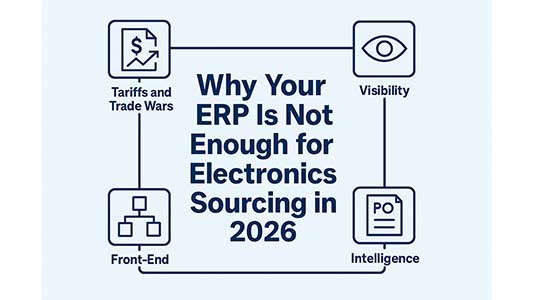Electronics sourcing is entering a new era. The events of the past five years—COVID-era shortages, geopolitical tensions, raw material inflation, and mounting compliance demands—have exposed the limitations of even the most sophisticated Enterprise Resource Planning (ERP) systems. In 2026, having an ERP is table stakes. Thriving in this environment requires something more: live data, API-native workflows, predictive insight, and trustable supplier automation.
Let’s unpack why traditional ERP-driven procurement no longer delivers what sourcing leaders need—and what’s emerging to fill the gap.
Tariffs and Trade Wars: Procurement Is a Moving Target
2024 and 2025 witnessed a resurgence in protectionist policies, with the US, EU, and China adjusting tariffs and export controls in real time. The semiconductor sector was especially impacted, with sanctions targeting advanced chips, battery chemistries, and dual-use technologies.
ERP systems, by design, are static and inward-facing. They operate on predefined supplier relationships and siloed product master data. When tariffs shift overnight or authorized supplier lists evolve due to regulatory action (as with the US Entity List or EU Deforestation Regulation), ERP workflows cannot adapt in real-time.
Buyers are left manually checking supplier status, rerouting POs, or—even worse—risking non-compliance.
Modern sourcing solutions must embed dynamic compliance intelligence. This includes:
• Live tariff impact calculators by country-of-origin.
• Automated routing to trade-compliant suppliers.
• Traceability tools that satisfy CRMA, CSRD, and LkSG requirements.
This isn’t just about price optimization—it’s about operational integrity.
From Visibility to Verifiability
Sourcing teams don’t just want to see supplier data. They want to trust it. In 2026, the credibility gap in ERP sourcing has grown. Static stock records,
outdated price lists, and email-driven RFQs no longer meet buyer expectations.
With BOMs spanning hundreds of components, a single inaccurate lead time or obsolete SKU can derail production.
Today’s best-in-class electronics procurement runs on verifiable data from:
- Live distributor APIs offering up-to-the-minute availability and pricing.
- PO acknowledgments, shipment tracking, and delivery status updates linked directly to the ERP.
- Secure credentialing of suppliers, including anti-counterfeit and RoHS/REACH documentation.
This evolution—from visibility to verifiability—demands tools that can ingest, standardize, and act upon real-time supplier signals. ERP isn’t designed for this. API-native sourcing platforms are.
Trust Is the New Currency
Buyers in electronics manufacturing increasingly operate under pressure—not just to source efficiently, but to mitigate risk.
In high-mix, low-volume environments (common in EMS, aerospace, and industrial applications), the cost of a sourcing error is not measured in cents per part—it’s measured in missed shipments, SLA penalties, and customer churn.
Yet most ERPs treat suppliers as static database entries rather than dynamic, behavior-rich partners. There’s no way to factor in responsiveness, fulfillment quality, or past reliability without extensive manual work.
Modern procurement platforms change this by offering:
- Supplier performance dashboards (based on quote-to-order win rates, delay frequency, etc.)
- Dynamic risk scoring factoring geopolitical exposure, delivery variance, and financial health.
- Collaborative quote workflows, replacing the email–Excel–PDF triage still common in many OEM/EMS firms.
Trust is no longer anecdotal. It’s measurable. And it must be built into the sourcing cockpit.
ERP is Back-End. Sourcing Needs a Front-End.
There’s a structural reason ERPs fail sourcing leaders: they weren’t built for real-time, multi-party collaboration.
Most ERP systems focus on internal control: financials, planning, stock, HR. Their procurement modules were bolted on, not designed for fluid engagement with 10+ global suppliers on every BOM.
But sourcing today is not just a back-office function. It’s an external workflow involving:
- BOM enrichment and feasibility analysis
- Component lifecycle management (PCN/EOL)
- Cross-supplier negotiation and availability checks
- Instant comparison of pricing, lead times, and logistics
This demands a new interface, built for:
- Uploading or syncing BOMs from PLM or ERP
- Triggering quotes or direct orders to multiple authorized suppliers
- Getting instant answers, not waiting days for email replies
- Integrating final decisions back into the ERP automatically
Just as CRM tools evolved beyond ERP to empower sales, sourcing needs its own operational layer—linked to ERP, but not limited by it.
The Age of Purchase Order Intelligence
The future of electronics sourcing isn’t just digital—it’s intelligent.
At Adesio, we call this Purchase Order Intelligence—the idea that every PO becomes a dynamic, strategic asset. It carries:
- Embedded supplier data
- Traceable compliance flags
- Predictive risk scoring
- Automated update triggers
In this model, the PO is no longer a static PDF. It’s a living object—negotiated, enriched, and executed via APIs, with full auditability.
This is not speculative. Already in 2025, API-driven POs are routing through major distributors like Arrow, TI, Avnet, and Mouser via solutions like Smart Supply
Manager®. Buyers in Europe and Asia are seeing cycle time reductions of 80%, error rate drops of 70%, and full traceability for CSRD and LkSG filings.
The ERP? It receives the confirmed PO for accounting and stock planning. But the sourcing happens elsewhere.
Conclusion: Sourcing Is Becoming a Strategic Engine
If the past taught us resilience, the future demands intelligence.
Electronics manufacturers can no longer afford to source based on static databases and email threads. The 2026 supply chain requires real-time orchestration, verifiable supplier data, trade compliance automation, and predictive insight.
ERPs remain essential—but they are not enough.
What’s needed is a sourcing layer designed for the real world: multi-vendor,
fast-moving, regulated, and global. A layer where API automation, supplier trust, and PO intelligence are native—not afterthoughts.
In this new reality, the winners won’t be those with the biggest ERP license. They’ll be those with the smartest sourcing cockpit.
About the Author:
Bertier Luyt is CEO of Adesio, the company behind Smart Supply Manager®, the first API-native sourcing solution for electronic components. He helps OEMs, EMS firms, and component distributors digitize the full RFQ-to-PO cycle and gain a strategic edge through Purchase Order Intelligence.
www.adesio.com












